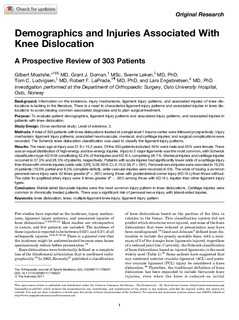| dc.contributor.author | Moatshe, Gilbert | |
| dc.contributor.author | Dornan, Grant J. | |
| dc.contributor.author | Løken, Sverre Bertrand | |
| dc.contributor.author | Ludvigsen, Tom C | |
| dc.contributor.author | LaPrade, Robert F. | |
| dc.contributor.author | Engebretsen, Lars | |
| dc.date.accessioned | 2018-05-18T12:28:35Z | |
| dc.date.available | 2018-05-18T12:28:35Z | |
| dc.date.created | 2017-10-10T13:28:58Z | |
| dc.date.issued | 2017 | |
| dc.identifier.citation | The Orthopaedic Journal of Sports Medicine. 2017, 5, 2325967117706521. | nb_NO |
| dc.identifier.issn | 2325-9671 | |
| dc.identifier.uri | http://hdl.handle.net/11250/2498585 | |
| dc.description | This open-access article is published and distributed under the Creative Commons Attribution - NonCommercial - No Derivatives License (http://creativecommons.org/licenses/by-nc-nd/3.0/), which permits the noncommercial use, distribution, and reproduction of the article in any medium, provided the original author and source are credited. You may not alter, transform, or build upon this article without the permission of the Author(s). For reprints and permission queries, please visit SAGE’s website at http://www.sagepub.com/journalsPermissions.nav. | nb_NO |
| dc.description.abstract | Background: Information on the incidence, injury mechanisms, ligament injury patterns, and associated injuries of knee dislocations is lacking in the literature. There is a need to characterize ligament injury patterns and associated injuries in knee dislocations to avoid missing common associated diagnoses and to plan surgical treatment. Purpose: To evaluate patient demographics, ligament injury patterns and associated injury patterns, and associated injuries in patients with knee dislocation. Study Design: Cross-sectional study; Level of evidence, 3. Methods: A total of 303 patients with knee dislocations treated at a single level 1 trauma center were followed prospectively. Injury mechanism; ligament injury patterns; associated neurovascular, meniscal, and cartilage injuries; and surgical complications were recorded. The Schenck knee dislocation classification was used to classify the ligament injury patterns. Results: The mean age at injury was 37.8 ± 15.3 years. Of the 303 patients included, 65% were male and 35% were female. There was an equal distribution of high-energy and low-energy injuries. Injury to 3 major ligaments was the most common, with Schenck classification type KD III-M constituting 52.4% of the injuries and KD III-L comprising 28.1%. Meniscal injuries and cartilage injuries occurred in 37.3% and 28.3% of patients, respectively. Patients with acute injuries had significantly lower odds of a cartilage injury than those with chronic injuries (odds ratio [OR], 0.28; 95% CI, 0.15-0.50; P < .001). Peroneal nerve injuries were recorded in 19.2% of patients (10.9% partial and 8.3% complete deficit), while vascular injuries were recorded in 5%. The odds of having a common peroneal nerve injury were 42 times greater (P < .001) among those with posterolateral corner injury (KD III-L) than those without. The odds for popliteal artery injury were 9 times greater (P ¼ .001) among those with KD III-L injuries than other ligament injury types.
Conclusion: Medial-sided bicruciate injuries were the most common injury pattern in knee dislocations. Cartilage injuries were common in chronically treated patients. There was a significant risk of peroneal nerve injury with lateral-sided injuries. | nb_NO |
| dc.language.iso | eng | nb_NO |
| dc.subject | knee dislocation | nb_NO |
| dc.subject | knee | nb_NO |
| dc.subject | multiple ligament knee injury | nb_NO |
| dc.subject | ligament injury pattern | nb_NO |
| dc.title | Demographics and injuries associated with knee dislocation: A prospective review of 303 patients | nb_NO |
| dc.type | Journal article | nb_NO |
| dc.type | Peer reviewed | nb_NO |
| dc.description.version | publishedVersion | nb_NO |
| dc.rights.holder | © The Author(s) 2017 | nb_NO |
| dc.source.journal | The Orthopaedic Journal of Sports Medicine | nb_NO |
| dc.identifier.doi | 10.1177/2325967117706521 | |
| dc.identifier.cristin | 1503654 | |
| dc.description.localcode | Seksjon for idrettsmedisinske fag / Department of Sport Medicine | nb_NO |
| cristin.unitcode | 150,34,0,0 | |
| cristin.unitname | Seksjon for idrettsmedisinske fag | |
| cristin.ispublished | true | |
| cristin.fulltext | original | |
| cristin.qualitycode | 1 | |
